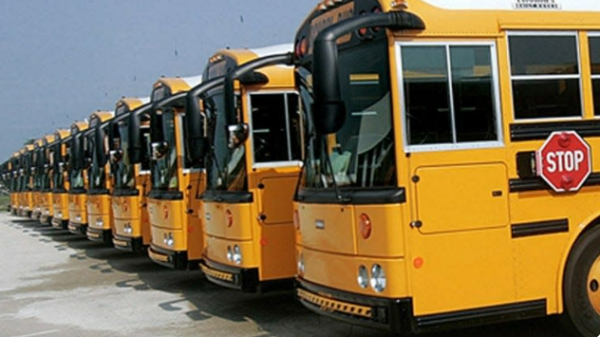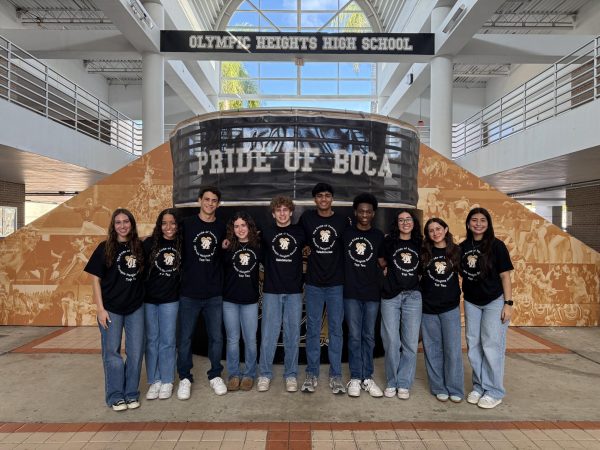Increased Youth Particpation Among Changes Evident in 2018 Midterm Elections
photo courtesy of bocanewspaper.com
Olympic Heights sophomore Anika Krieger (left) and her sister junior Genevieve Krieger worked to encourage student involvement in the political process leading up to the 2018 midterm elections.
The 2018 midterm elections on Wednesday, Nov. 6 were record breaking, with voter participation exceeding over 100 million for the first time in history. In comparison to the past two midterm elections where percentage of voter turnout was 36.4 percent in 2014 and 41 percent in 2010, this election had 49 percent of eligible voters participating; the numbers haven’t been that high since 1966.
Along with the record-breaking participation, other notable events happened during this election. The Democratic Party gained control of the House of Representatives, but lost seats in the Senate. Despite not being in control in the Senate, the Democrats now have much more power to curtail the Trump/Republican agenda with control of the House.
Additionally, the 2018 midterms saw many women, minorities, and LGBT persons winning seats in Congress. Newly elected, Kansas Congresswoman Sharice Davids is the first openly gay Native American person elected to congress. New Mexico Congresswoman Debra Haaland will become the first Native American women elected to Congress, along with Davids. Jared Polis, in Colorado, is the first openly gay man elected governor. Michigan democrat Rashida Tlaib, and Minnesota democrat Ilhan Omar are the first Muslim women elected to congress.
In Florida, voters approved the passed the largest expansion of voting rights since the Voting Rights Act in 1965 by passing the Voting Restoration Amendment, restoring the voting rights of Floridians with felony convictions after they complete all terms of their sentence including parole or probation. As a result, 1.4 million Floridians who weren’t allowed to vote in the 2018 midterms will be eligible to vote in the next election. are now being given that privilege.
In past midterm elections, the majority of voters were older, white men, but younger generations were more animated about voting this election. The encouragement for younger generations to vote was evident in our school with an organization called First Vote helping any eligible students register.
Sophomore Anika Krieger and her sister junior Genevieve Krieger were active in the process of helping students register at Olympic Heights. “It’s true that my sister and I are not able to vote yet, but we certainly are not blind to what’s going on around us,” explains Anika. “We can’t see any reason to wait until we are 18 to get our generation engaged and active.”
In the 2014 midterm election. Only 19.9 percent of 18-29 year olds voted, an all time low since the voting age was lowered to 18 in 1971. However, a new wave of youth activism has led to a surge in votes among the younger demographic. Preliminary results from ABC exit polls indicate a 188 percent increase in voter participation from the 18-29 year old demographic, according to data from TargetSmart, a political-data-analysis firm.
Voting can be can result in major change in government. “Policies that elected officials put in place, like allowing pre-existing conditions for health care, are things that will affect us on a granular, daily level for the rest of our lives,” Anika Krieger comments. Health care, taxes, education, and every aspect of American life is decided by the government, and voting is one way to have a hand in the decisions being made.
Many elections are close-call situations with small margins separating the winner and loser. “Because of the Electoral College, George Bush was elected President by a margin of 537 votes, right here in Florida — that’s about the same number of people that are in the sophomore class. To say your vote doesn’t matter is simply not true,” Genevieve Krieger explains.
Two perfect examples of razor thin election results can be found in Florida. With many votes still uncounted (mainly absentee and provisional ballots), the race for the U.S. Senate sees Republican Rick Scott holding a 0.28 percent lead over incumbent Democrat Bill Nelson. In Florida’s gubernatorial race, Republican Ron DeSantis holds a 0.53 percent lead over Democrat Andrew Gillum.
Florida election law mandates an automatic vote recount for races decided by one-half percent or less. The senate race is certainly headed to a recount, and as Gillum slowly closes the gap as more ballots are counted in the gubernatorial race, it appears likely that contest will be headed to a recount as well. Time will tell, but the growing youth vote in Florida is thought to be a primary factor in these two races being so closely contested.
If America’s youngest voters continue to stay engaged in the political process, we can expect a shifting tide in future elections, quite possibly reshaping our political landscape.











N.I. • Nov 9, 2018 at 11:26 pm
Best friend wrote the best article!
Genevieve • Nov 8, 2018 at 11:49 am
I love it!!! Thank you!!!!!